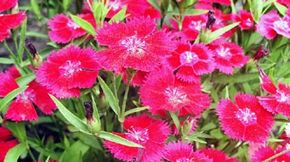The old-fashioned carnation name pinks comes from the serrated flower edges, which look as if cut with pinking shears. And the name of the color pink is said to come from these perennials, which have been popular in gardens for hundreds of years. The many dianthus species and hybrids come in red, white, orange, purple, cranberry, and of course, many shades of pink. Flower size ranges from less than an inch to several inches wide, and height ranges from just a few inches to several feet tall.
How to grow: Dianthus prefers average to rich well-drained soil in full or nearly full sun. Refresh older plantings by dividing and resetting plants every few years.
Advertisement
Propagation: Named cultivars must be grown from cuttings or divisions, while others can be grown from seed.
Uses: Dianthus grows in beds and in pots equally well. Flowers last a long time in bouquets.
Related species: Dianthus caryophyllus is the florist's carnation, which is usually greenhouse grown in conditions that are neither too hot nor too cold; D. barbatus is Sweet William, a biennial that sometimes lasts for several years; D. gratianopolitanus is the gray-green leaved mat-forming type that blooms once a year and is excellent in flower borders and rock gardens.
Scientific name: Dianthus species
Advertisement
